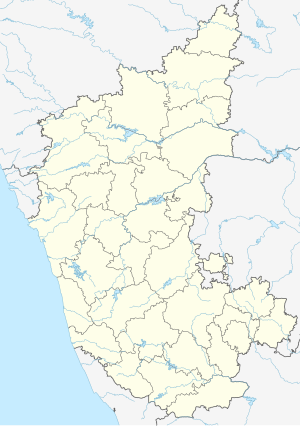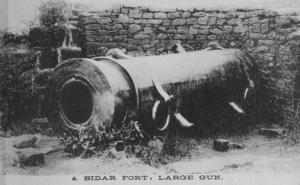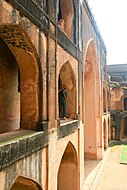The Deccan Sultanates were five late-medieval Indian kingdoms—on the Deccan Plateau between the Krishna River and the Vindhya Range—that were ruled by Muslim dynasties: namely Ahmadnagar, Berar, Bidar, Bijapur, and Golconda. The sultanates had become independent during the break-up of the Bahmani Sultanate. The five sultanates owed their existence to the declaration of independence of Ahmadnagar in 1490, followed by Bijapur and Berar in the same year. Golconda became independent in 1518, and Bidar in 1528.

Bijapur, officially known as Vijayapura, is the district headquarters of Bijapur district of the Karnataka state of India. It is also the headquarters for Bijapur Taluk. Bijapur city is well known for its historical monuments of architectural importance built during the rule of the Adil Shahi dynasty. It is also well known for the popular Karnataka premier league team, the Bijapur Bulls. Bijapur is located 519 km (322 mi) northwest of the state capital Bangalore and about 550 km (340 mi) from Mumbai and 210 km (130 mi) north east of the city of Belgaum.
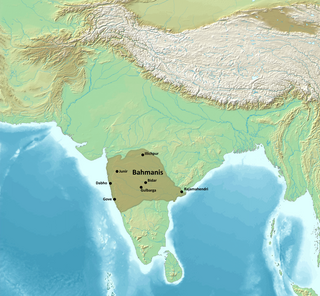
The Bahmani Sultanate was a late medieval Muslim empire that ruled the Deccan Plateau in South India. The Bahmani Sultanate came to power in 1347 during the Rebellion of Ismail Mukh against the Tughlaq dynasty of Delhi after Ismail Mukh abdicated in favour of Zafar Khan, who would establish the Bahmani Sultanate. The Bahmani Sultanate was in perpetual war with its neighbors, including its rival to the south, the Vijayanagara Empire.

Bidar (/biːd̪ər/) is a city in the north-eastern part of Karnataka state in India. It is the headquarters of Bidar district, which borders Maharashtra and Telangana. It is a rapidly urbanising city in the wider Bidar Metropolitan area. The city is well known for its many sites of architectural, historical and religious importance. Bidar City have a population of more than 2 lakh and are likely to get upgraded to municipal corporation in the next 5 years.

The Adil Shahi or Adilshahi, was a Shia, and later Sunni Muslim, dynasty founded by Yusuf Adil Shah, that ruled the Sultanate of Bijapur, centred on present-day Bijapur district, Karnataka in India, in the Western area of the Deccan region of Southern India from 1489 to 1686. Bijapur had been a province of the Bahmani Sultanate (1347–1518), and member of the Deccan Sultanates, before its political decline in the last quarter of the 15th century and eventual break-up in 1518. The Bijapur Sultanate was fully absorbed into the Mughal Empire on 12 September 1686, after its conquest by the Emperor Aurangzeb.

Indo-Islamic architecture is the architecture of the Indian subcontinent produced by and for Islamic patrons and purposes. Despite an initial Arab presence in Sindh, the development of Indo-Islamic architecture began in earnest with the establishment of Delhi as the capital of the Ghurid dynasty in 1193. Succeeding the Ghurids was the Delhi Sultanate, a series of Central Asian dynasties that consolidated much of North India, and later the Mughal Empire by the 15th century. Both of these dynasties introduced Islamic architecture and art styles from West Asia into the Indian subcontinent.

The Sultanate of Bidar was one of the Deccan sultanates of late medieval India. The sultanate emerged under the rule of Qasim Barid I in 1492 and leadership passed to his sons. Starting from the 1580s, a wave of successions occurred in the rulership of the dynasty which ended in 1609 under the last Sultan Amir Barid III who was eventually defeated in 1619 by the Bijapur sultan Ibrahim Adil Shah II. Bidar became annexed into the Bijapur Sultanate.

Narnala Fort or Narnala Qila Sarkar, also known as Shahnoor Fort, is a hill fortress in the Satpura Range of Vidarbh, Maharashtra, India, named after the Rajput Solanki Chaulukya Ruler, Raja Narnal Singh, also known as Narnal Singh Swami. It was renamed as "Shahnoor" by Islamic rulers but again acquired, rebuilt and got its name "Narnala" by ruler Rao Rana Narnal Singh Solanki, who migrated from Patan in Gujarat.

Kondapalli Fort, also locally known as Kondapalli Kota and Kondapalli Quilla, lies to the west of Kondapalli in Ibrahimpatnam mandal of NTR district in Andhra Pradesh, India was built by Prolaya Vema Reddy of Reddi Kingdom during the 14th century CE. It was initially built as a leisure place and business center and later served as a military training base for the British rulers. According to some other historians it was built in 1360 CE by Anna Vema Reddy after he captured Kondapalli from Mudigonda Chalukyas, the fort has been home to several dynasties, from the Reddi rulers Gajapati dynasty to the Nizam Nawabs, and then the East India Company.
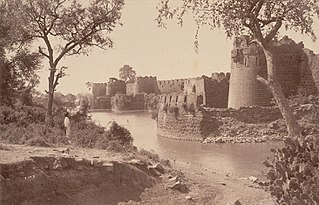
The Gulbarga Fort is located in Kalaburagi in the Kalaburagi district of North Karnataka. This fort was originally constructed by a hindu king Raja Gulchand, it was subsequently significantly enlarged in 1347 by Al-ud-din Hasan Bahmani of the Bahmani Dynasty after he cut off his ties with the Delhi Sultanate; Islamic monuments such as mosques, palaces, tombs, and other structures were also built later within the refurbished fort. The Jama Masjid built later, within the fort, in 1367, is a unique structure built in Persian architectural style, fully enclosed, with elegant domes and arched columns, which is unlike any other mosque in India. It was built to commemorate the establishment of the dynastic rule of the Bahmani kingdom at Kalaburagi fort between 1327 and 1424. It remained the capital of the Bahmani Kingdom till 1424 where after the capital was shifted to Bidar Fort, as Bidar had better climatic conditions.

The Bijapur Fort is located in the Bijapur city in Bijapur District of the Indian state of Karnataka. Bijapur fort has a plethora of historical monuments of architectural importance built during the rule of Adil Shahi dynasty.
Basavakalyana fort, earlier known as Kalyana fort, is located in Bidar district in the Indian state of Karnataka. Its historic importance is dated to the 10th century. The capital of Chalukyas was also shifted from Manyakheta to Kalyana in the 10th century. The fort, integral to the Basavakalyana town, is also famous as Karmabhoomi of Basavanna and hundreds of other Sharanas.

Warangal Fort is located in Warangal District, Telangana, India. It was the capital city of Kakatiya dynasty and the Musunuri Nayakas. It appears to have existed since at least the 12th century when it was the capital of the Kakatiyas. The fort has four ornamental gates, known as Kakatiya Kala Thoranam, that originally formed the entrances to a now ruined great Shiva temple. The Kakatiyan arch has been adopted and officially incorporated into the emblem of Telanganaafter the bifurcation of Andhra Pradesh. The fort is included in the "tentative list" of UNESCO World Heritage Site and was submitted by the Permanent Delegation of India to UNESCO on 10/09/2010.
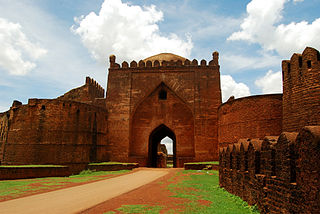
Deccani architecture, particularly the architecture of the Bahmani and Deccan Sultanates, is the architecture of the Deccan Plateau, and is a regional variant of Indo-Islamic architecture. It was heavily influenced by the styles of the Delhi Sultanate and later Mughal architecture, but sometimes also directly influenced from Persia and Central Asia.

Ali Barid Shah I was the third ruler of the Barid Shahi dynasty at Bidar. He succeeded his father in 1540, and ruled until his death in 1580. He was considered a man of letters, and invited scholars and craftsmen from all over the Indian subcontinent to his capital. He is also known to have played a key logistical role in the Battle of Talikota.
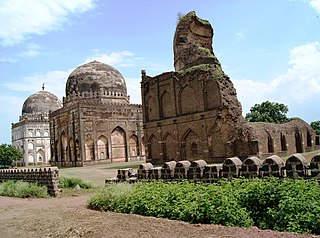
The Bahmani tombs complex at Bidar is the necropolis of the Bahmani dynasty, located in Bidar, in the Indian state of Karnataka.

The Haft Gumbaz, also spelt Haft Gumbad are a group of tombs of the Bahmani dynasty situated in Kalaburagi, in the Indian state of Karnataka. Built during the 14th and 15th centuries, the tombs are examples of early Indo-Islamic architecture. There are seven tombs in total, with four being tombs of the rulers of the Bahmani dynasty. The tomb complex is a monument of national importance, maintained by the Archeological Survey of India. The tomb complex is part of the "Monuments and Forts of the Deccan Sultanate", which is an ensemble of various structures added to the tentative list of the UNESCO World Heritage Sites.
The Turquoise Throne or Takht-i-Firoza was a famous jewel-studded royal throne of the Bahmani Sultans of Deccan in India. It was a gift by Musunuri Kapaya Nayaka, then king of Warangal, during the Bahmani-Vijayanagar War, where the Bahmanis defeated the latter. Over some time, this throne became one of the most important icons of the Bahmani royalty and heritage.
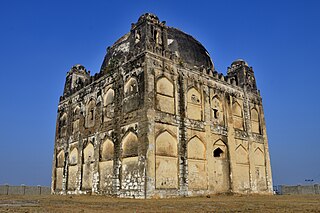
Chor Gumbad, Kalaburagi is a domed building in Kalaburagi. It is listed as a state protected monument.

